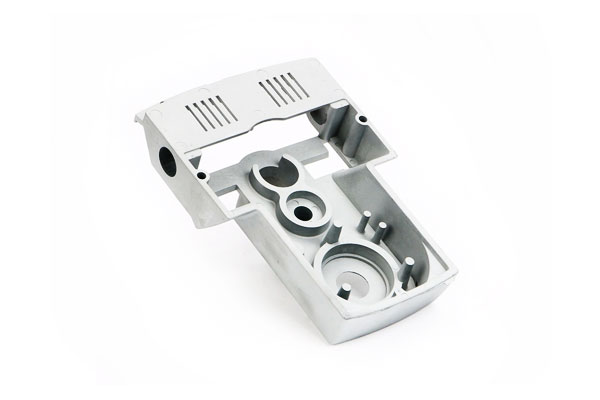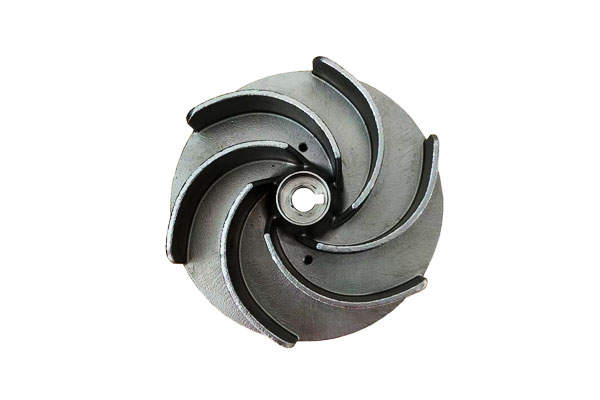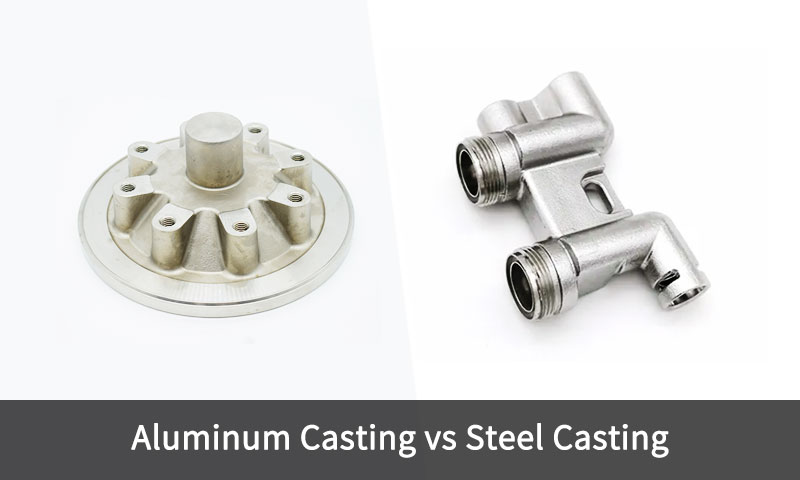1. Ievads
Aluminum vs Steel Casting — choosing between these two foundational materials shapes component performance, cost and manufacturability across industries from automotive to energy.
This comparison is not merely about metal chemistry: it encompasses density and stiffness, termiskā uzvedība, casting process compatibility, secondary processing (termiskā apstrāde, virszemes inženierija), lifecycle cost and application-specific reliability.
Engineers and purchasers must therefore evaluate the entire system—loading, temperatūra, environment, production volume and finish requirements—before specifying a metal and casting route.
2. Fundamental Material Differences Between Aluminum vs Steel
At the core of aluminum vs. steel casting lies a fundamental metallurgical and physical contrast that directly affects how each material behaves during casting, apstrāde, un pakalpojums.
| Īpašums | Alumīnijs (Piem., Al-i atslābst) | Tērauds (Piem., carbon or low-alloy steels) | Ietekme uz inženierzinātnēm |
| Blīvums (G/cm³) | 2.70 | 7.85 | Aluminum is ~65% lighter, offering major weight savings for transportation and aerospace. |
| Kušanas temperatūra (° C) | 615–660 | 1425–1540 | Aluminum’s low melting point enables easier casting and lower energy consumption; steel requires specialized furnaces. |
| Siltumvadītspēja (Ar m/m · k) | 120–180 | 40–60 | Aluminum dissipates heat efficiently—ideal for engines, siltummaiņi, un elektronika. |
| Īpašs spēks (MPa/ρ) | ~100–150 | ~70–90 | Despite lower absolute strength, aluminum’s strength-to-weight ratio surpasses that of steel. |
| Elastības modulis (GPA) | 70 | 200 | Steel is stiffer, providing better rigidity under load and vibration. |
Izturība pret koroziju |
Lielisks (forms Al₂O₃ layer) | Mainīgs; prone to rust without coatings | Aluminum resists oxidation naturally, while steel needs surface protection (gleznošana, apjoms, or alloying with Cr/Ni). |
| Mašīnīgums | Lielisks | Mērens līdz grūts | Aluminum’s softness allows easy machining and shorter cycle times; steel requires tougher tooling. |
| Pārstrāde | >90% recoverable | >90% recoverable | Both materials are highly recyclable, though aluminum’s remelting requires less energy (5% of primary production). |
| Casting Shrinkage (%) | 1.3–1.6 | 2.0–2.6 | Steel shrinks more during solidification, demanding larger allowances and more complex gating/feeding systems. |
| Maksāt (apm., USD/kg) | 2.0–3.0 | 0.8–1.5 | Aluminum is more expensive per kilogram, but savings in weight and processing can offset total lifecycle costs. |
3. What Is Aluminum Casting?
Alumīnijs liešana is the process of shaping molten aluminum or aluminum alloys into complex, near-net-shape components using molds.
It is one of the most widely used metal casting processes globally—accounting for over 50% of all nonferrous castings—due to aluminum’s excellent castability, zems blīvums, un izturība pret koroziju.

Pārskats
In aluminum casting, izkusis alumīnijs (parasti starp 680–750°C) is poured or injected into a mold cavity where it solidifies into the desired geometry.
Aluminum’s low melting point and high fluidity make it ideal for both mass-production methods (like die casting) un Augstas precizitātes lietojumprogrammas (like investment casting).
Key Features of Aluminum Casting
- Viegla un augstas stiprības un svara attiecība:
Aluminum castings offer excellent mechanical performance while being about viena trešdaļa tērauda svara. - Laba izturība pret koroziju:
Plāns, pašdziedināšana aluminum oxide layer (Al₂o₃) protects against oxidation and most atmospheric or marine corrosion. - Lieliska termiskā un elektriskā vadītspēja:
Suitable for applications like siltummaiņi, apvalki, and electric components. - Pārstrāde:
Aluminum can be recycled indefinitely without degradation, reducing production energy by up to 95% compared to primary smelting.
Common Aluminum Casting Processes
| Liešanas metode | Apraksts | Tipiskas lietojumprogrammas |
| Liešana | High-pressure injection of molten aluminum into steel dies; yields precise, plānas sienas daļas. | Automobiļu detaļas (pārnesumu apvalki, iekavas), Patēriņa elektronika. |
| Smilšu liešana | Molten metal poured into sand molds; suitable for larger, lower-volume parts. | Motora bloki, daudzveidība, kosmosa korpusi. |
| Investīciju liešana | Ceramic molds from wax patterns; ideal for fine details and tight tolerances. | Aviācijas un kosmosa turbīnu komponenti, medicīniskās ierīces. |
| Pastāvīga pelējuma liešana | Reusable metal molds; good surface finish and dimensional control. | Virzuļi, riteņi, un jūras komponenti. |
| Centrbēdze | Uses centrifugal force to distribute molten metal; blīvs, Bez defektu struktūra. | Caurules, piedurknes, and rings. |
Alumīnija liešanas priekšrocības
- Viegls: Reduces component weight by 30–50% vs. tērauds, improving fuel efficiency (autobūves) or payload capacity (avi kosmosa).
- Energoefektivitāte: Melting aluminum requires 60–70% less energy than steel (570° C pret. 1420° C), lowering processing costs by 20–30%.
- Izturība pret koroziju: Eliminates the need for coatings (Piem., krāsot, cinkojošs) Lielākajā daļā vides, reducing maintenance costs by 40–50%.
- High-Volume Viability: Die casting enables production of 1000+ parts/day per machine, meeting consumer goods demand.
Disadvantages of Aluminum Casting
- Zemāka izturība: Stiepes izturība (150–400 MPa) is 50–70% lower than high-strength steel, limiting use in heavy-load applications.
- Poor High-Temperature Performance: Retains only 50% of room-temperature strength at 250°C, making it unsuitable for engine exhaust or power plant components.
- Porainības risks: Die-cast aluminum is prone to gas porosity (from high-pressure injection), restricting heat treatment options (Piem., T6 temper requires vacuum processing).
- Higher Raw Material Cost: Primary aluminum costs $2,500–$3,500/tonne, 2–3x more than carbon steel.
Industrial Applications of Aluminum Casting
Aluminum casting is widely used across multiple industries due to its combination of viegls dizains, mašīnīgums, un izturība pret koroziju:
- Automašīna: Motora bloki, transmisijas korpusi, riteņi, and suspension arms.
- Aviācija: Iekavas, strukturālie veidgabali, Kompresoru apvalki.
- Elektronika: Siltuma izlietnes, autoseķi, iežogojums.
- Patēriņa preces: Ierīces, elektroinstrumenti, mēbeļu aparatūra.
- Marine and Renewable Energy: Propelleri, apvalki, un turbīnu asmeņi.
4. What Is Steel Casting?
Steel casting is the process of pouring molten steel into a mold to produce complex, high-strength components that cannot be easily fabricated or forged.
Unlike aluminum, steel has a augstāks kausēšanas punkts (≈ 1450–1530°C) and greater tensile strength, padarot to ideālu load-bearing and high-temperature applications such as machinery, infrastructure, un enerģijas ražošana.

Pārskats
In steel casting, carefully alloyed molten steel is poured into either expendable (smiltis, ieguldījums) or permanent molds, where it solidifies into a shape close to the final part.
Because steel shrinks significantly upon cooling, precise temperature control, vārtu dizains, and solidification modeling ir kritiski.
Steel castings are known for their mehāniska izturība, trieciena pretestība, un strukturālā integritāte, particularly under harsh service conditions.
Key Features of Steel Casting
- Exceptional Strength and Toughness:
Yield strengths often exceed 350 MPA, with heat-treated alloys reaching over 1000 MPA. - High-Temperature Capability:
Retains strength and oxidation resistance up to 600–800°C, depending on composition. - Versatile Alloy Selection:
Includes oglekļa tēraudi, Zema sakausējuma tēraudi, nerūsējoši tēraudi, and high-manganese steels, each tailored for specific environments. - Metināmība un apstrādājamība:
Cast steels can be post-processed effectively—machined, metināts, and heat-treated to enhance performance.
Common Steel Casting Processes
| Liešanas metode | Apraksts | Tipiskas lietojumprogrammas |
| Smilšu liešana | Molten steel poured into bonded sand molds; Ideāli lielam, sarežģītas daļas. | Vārstu ķermeņi, sūkņu apvalki, machinery housings. |
| Investīciju liešana | Ceramic molds formed from wax patterns; yields excellent accuracy and surface finish. | Turbīnu asmeņi, ķirurģiski rīki, kosmiskās aviācijas daļas. |
| Centrbēdze | Rotational force distributes molten steel evenly; produces dense cylindrical components. | Pīpes, starplikas, nesošās sacīkstes. |
| Apvalka liešana | Uses thin resin-coated sand molds; allows higher precision and smoother surfaces. | Mazas motora daļas, iekavas. |
| Nepārtraukta liešana | For semi-finished steel products like slabs and billets. | Raw material for rolling and forging. |
Advantages of Steel Casting
- Augstāks spēks & Izturība: Stiepes izturība (līdz 1500 MPA) and impact toughness (40–100 J) make it irreplaceable for structural safety (Piem., tilta sastāvdaļas, automobiļu šasija).
- Augstas temperatūras veiktspēja: Operates reliably at 400–600 ° C (vs. aluminum’s 250°C limit), suitable for jet engine casings and power plant boilers.
- Low Raw Material Cost: Carbon steel costs $800–$1200/tonne, 60–70% less than primary aluminum.
- Nodilums pretestība: Heat-treated steel (Piem., 4140) has surface hardness up to 500 HB, reducing replacement frequency in abrasive applications by 50–70%.
Disadvantages of Steel Casting
- High Weight: Density 2.7x that of aluminum increases fuel consumption (autobūves) or structural load (ēkas).
- High Energy Use: Melting steel requires 25–30 MWh/tonne (vs. 5–7 MWh/tonne for aluminum), increasing processing costs by 40–50%.
- Jutība pret koroziju: Carbon steel rusts in moist environments (korozijas ātrums: 0.5–1,0 mm gadā in salt spray), requiring coatings (Piem., cinkojošs) that add $1.5–$2.5/kg to costs.
- Poor Machinability: Hardness requires specialized tools, Palielināts apstrādes laiks pēc 30–50% vs. alumīnijs.
Industrial Applications of Steel Casting
Steel castings dominate industries demanding izturība, izturība, un karstuma pretestība:
- Būvniecība & Kalnrūpniecība: Excavator teeth, drupinātāju daļas, track links.
- Enerģija & Enerģijas ražošana: Steam turbine casings, vārstu ķermeņi, kodolkomponenti.
- Eļļas & Gāze: Drill heads, pipeline valves, daudzveidība.
- Transports: Train couplers, pārnesumu apvalki, heavy-duty engine blocks.
- Aviācija & Aizsardzība: Piezemēšanās piederumi, strukturālie veidgabali, armor components.
5. Visaptverošs salīdzinājums: Alumīnijs pret tērauda liešanu
Process fit and part geometry
- Plānas sienas, komplekss, liela apjoma daļas: aluminum die casting is optimal (HPDC).
- Liels, smags, load-bearing parts: steel/spheroidal graphite (Hercogi) iron and cast steels via sand casting are preferred.
- Medium volume with high integrity requirements: low-pressure aluminum or investment casting steels depending on strength needs.
Mechanical performance & pēcapstrāde
- Termiskā apstrāde: cast steel can be quenched & tempered to obtain high strength and toughness; aluminum alloys have age-hardening routes but reach lower maximum strengths.
- Surface engineering: aluminum readily anodizes; steel can be nitrided, carburized, induction hardened or coated with hard substances (keramika, Hard Chrome).
Izmaksu autovadītāji (typical considerations)
- Material cost per kg: aluminum raw metal tends to be priced higher per kg than ferrous scrap/steel, but part mass reduces required amount.
- Instrumentus: die casting dies are expensive (high initial amortization) but low per-part cost at volumes >10k–100k; sand tooling is cheap but per-part labor higher.
- Apstrāde: aluminum machines faster (higher removal rates), lower tool wear; steel requires harder tooling and more machining time—raises total cost especially for small batches.
Ražošana & defect modes
- Porainība: HPDC aluminum can develop gas and shrinkage porosity; permanent-mold and low-pressure reduce porosity.
Steel castings can suffer inclusions and segregation; controlled melting and post-HT reduce defects. - Izmēru kontrole: die cast aluminum attains tight tolerances (± 0,1–0,3 mm); sand cast steel tolerances are looser (±0.5–2 mm) without post-machining.
Vide & life-cycle
- Pārstrāde: both metals are highly recyclable. Recycled aluminum uses a small fraction (~5–10%) of the energy of primary smelting; recycled steel also has large energy savings compared to virgin iron.
- Use-phase: lightweight aluminum can reduce fuel consumption in vehicles — a system-level environmental benefit.
Galotne: Aluminum vs Steel Casting — Key Technical Comparison
| Kategorija | Alumīnija liešana | Tērauda liešana |
| Blīvums (G/cm³) | ~2.70 | ~7.80 |
| Kušanas temperatūra (° C / ° F) | 660° C / 1220° F | 1450–1530°C / 2640–2790°F |
| Izturība (Stiepts / Ienest, MPA) | 130–350 / 70–250 (tikpat ietērpts); līdz 500 Pēc termiskās apstrādes | 400–1200 / 250–1000 (Atkarībā no pakāpes un termiskās apstrādes) |
| Cietība (HB) | 30–120 | 120–400 |
| Elastības modulis (GPA) | 70 | 200 |
| Siltumvadītspēja (Ar m/m · k) | 150–230 | 25–60 |
| Elektriskā vadītspēja (% IACS) | 35–60 | 3–10 |
| Izturība pret koroziju | Lielisks (Dabiskais oksīda slānis) | Variable — requires alloying (Krekls, Iekšā, Noplūde) vai pārklājums |
| Izturība pret oksidāciju (High-Temp) | Ierobežots (<250° C) | Labs līdz izcils (up to 800°C for some alloys) |
| Mašīnīgums | Lielisks (mīksts, easy to cut) | Mēreni vai nabadzīgi (grūtāks, abrazīvs) |
| Liešana (Šķidrums & Saraušanās) | Augsta plūstamība, Zema saraušanās | Lower fluidity, higher shrinkage — needs precise gating |
| Svara priekšrocība | ~65% lighter than steel | Heavy — suitable for structural loads |
Virsmas apdare |
Izlīdzināt, good detail reproduction | Rougher surfaces; may need machining or shot blasting |
| Heat Treatment Flexibility | Lielisks (T6, T7 tempers) | Plats (rūdīšana, rūdīšana, rūdījums, normalizēšana) |
| Pārstrāde | >90% recycled efficiently | >90% recyclable but requires higher remelting energy |
| Production Cost | Lower energy, Ātrāks cikla laiks | Higher melting cost and tool wear |
| Tipiskas pielaides (mm) | ±0.25 to ±0.5 (mirkšana); ±1.0 (smilšu liešana) | ±0.5–1.5 depending on process |
| Environmental Footprint | Zems (especially recycled aluminum) | Higher CO₂ and energy footprint due to high melting point |
| Tipiskas lietojumprogrammas | Automobiļu riteņi, apvalki, kosmiskās aviācijas daļas, patēriņa preces | Vārsti, turbīnas, smagā mašīna, strukturālās sastāvdaļas |
6. Secinājums
Aluminum and steel castings solve different engineering problems.
Aluminum excels where viegls svars, siltumvadītspēja, surface quality and high production rates matter.
Tērauds (and cast irons) dominate where lielas izturības, stīvums, nodilums pretestība, toughness and elevated temperature performance nepieciešami.
Good material selection balances functional requirements, maksāt (total life cycle), producibility and finishing.
In many modern designs hybrid solutions appear (steel inserts in aluminum castings, clad or bimetallic components) to exploit the strengths of both metals.
FAQ
Kas ir stiprāks: cast aluminum or cast steel?
Cast steel is significantly stronger—A216 WCB steel has a tensile strength of 485 MPA, 67% higher than A356-T6 aluminum (290 MPA).
Steel also has far greater toughness and wear resistance.
Can cast aluminum replace cast steel?
Only in applications where weight reduction is prioritized over strength (Piem., automotive non-structural parts).
Steel is irreplaceable for high-load, high-temperature components (Piem., turbīnu apvalki).
Which is more corrosion-resistant: cast aluminum or cast steel?
Cast aluminum is more corrosion-resistant in most environments (korozijas ātrums <0.1 mm/gadā) vs. oglekļa tērauds (0.5–1,0 mm gadā).
Stainless steel castings match aluminum’s corrosion resistance but cost 2–3x more.
Which casting process is best for aluminum vs. tērauds?
Aluminum is ideal for die casting (apjoms) and sand casting (zemu cenu).
Steel is best for sand casting (lielas daļas) un investīciju liešana (komplekss, high-tolerance components). Die casting is rarely used for steel.


